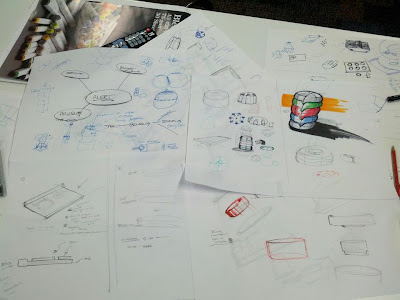Theme: "Design Resolution"
Introduction
This week our design team had an oral presentation with the format being a round table discussion. The team was able to receive feedback on our progress to date in order to identify problems and gain approval for our concept. The team made sure we addressed the three key elements, object, behaviour and scenario. The format of the presentation is displayed in the image below:
Tutorial
Tutorial
The team presented our concept from week 8 which was the office task management system. The feedback we received from the tutors and lecturer primarily revolved around issues with the context / scenario. The teaching staff outlined the pertaining issues involved with the office context, these included previously determined technological capabilities such as email and phones, general office etiquette restrictions on human behaviour, interference with employee's current work space environment and safety concerns relating to the height of the overall unit.
Below are a few images of the group's presentation:
After receiving this feedback the team organised a meeting and started to brainstorm ideas for new scenarios and contexts. In regards to my individual contribution, I came up with two new applications for the original design and two new scenarios / contexts. Our team's meeting and collaboration process is displayed below in the following images:
Below are a few images of the group's presentation:
After receiving this feedback the team organised a meeting and started to brainstorm ideas for new scenarios and contexts. In regards to my individual contribution, I came up with two new applications for the original design and two new scenarios / contexts. Our team's meeting and collaboration process is displayed below in the following images:
My first concept was a management system for people who have just been involved in a serious accident, for example, a car crash. These types of patients will require an intensive rehabilitation program in order to regain their previous health. The idea behind rehabilitation programs is to offer people who have suffered serious injuries a step by step system to help them get back on their feet. Throughout the program patients are able to see their progress to date, but for some it may be hard to keep track of their progress but more importantly maintain a good level of motivation to continue with the program. As a result, my concept idea is a progress management system for people in rehabilitation programs. The idea is to help keep patients motivated to achieve their goals while keeping up-to-date with their progress. Each of their stages in the program will be represented by "building blocks" which can be manipulated and interacted with by the patient to alert the associated health practitioner of their status.
The second concept builds on the first concept by linking the relevant health practitioners to allow a more collective and efficient collaboration process. Patients who are involved in rehabilitation programs are more than likely to have numerous health practitioners at any one time, ranging from doctors, physios to Musculoskeletal therapists. Having so many practitioners to worry about and making sure you keep in touch with all of them can be frustrating and time consuming for both the patient and practitioners. As a result, my concept idea is to provide a system which links all of the health practitioners and allows the patient to send them alerts and easily get in contact with them when needed. Patients will be able to monitor their sessions with each practitioner while also keeping track of their overall success in the program.
After much deliberation amongst the group we all decided to go with my second concept. However, this concept will be constantly reviewed and modified by the group as the semester progresses. The concept is more than likely going to change through further development.
Below is some of my preliminary research for the concept above:
Below is some of my preliminary research for the concept above:










.JPG)













